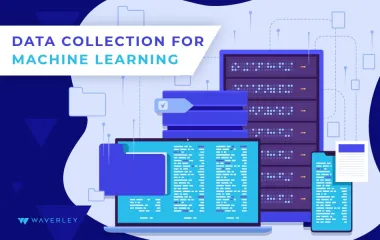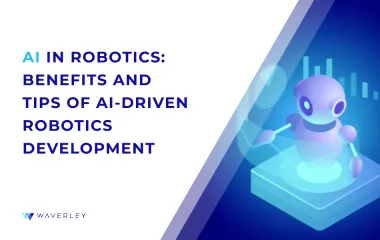Why Use Python for AI and Machine Learning
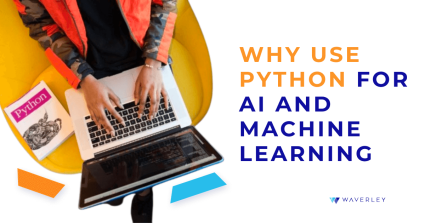
Contents
Nowadays Artificial Intelligence and Machine Learning are very widespread and commonly used by businesses of different sizes and across industries. The Deloitte research states that AI-based software is the latest trend in the technological transformation aimed at the improvement of productivity. It is predicted that within the next 24 months, the number of companies that use AI in their products and processes to achieve greater efficiency and strategic goals will likely increase.
AI and ML projects are used to process loads of data to offer a better user experience. In FinTech, AI is applied to make financial predictions, Healthcare AI systems can analyze patterns in a patient’s medical history. AI also allows for articulated robots to perform tasks faster and more accurately, and the Travel & Hospitality industry uses AI to deliver personalized suggestions, launch chatbots or ChatGPT integration.
Being excellent for processing or analyzing huge volumes of data, AI handles the work that cannot be done manually. The majority of such projects use Python for AI and Machine Learning. Waverley’s engineers also believe that this programming language is a top choice for the task. In this article, we’ll tell you a little about Python’s features which make it such a great solution for AI and ML projects. We will cover the reasons for AI and ML popularity, the trends, the most optimal choices for a programming language for AI, why and how Python for AI and Machine Learning is used, as well as real-life cases of AI applications made with the help of Python.
The Rise of AI and Machine Learning
AI and ML have rapidly grown and become widely embraced in various industries in recent years.
Let’s look at the AI statistics and the most popular trends.
According to Grand View Research, the global Artificial Intelligence market size was valued at USD 196.63 billion in 2023 and is projected to expand at a compound annual growth rate (CAGR) of 37.3% from 2023 to 2030.
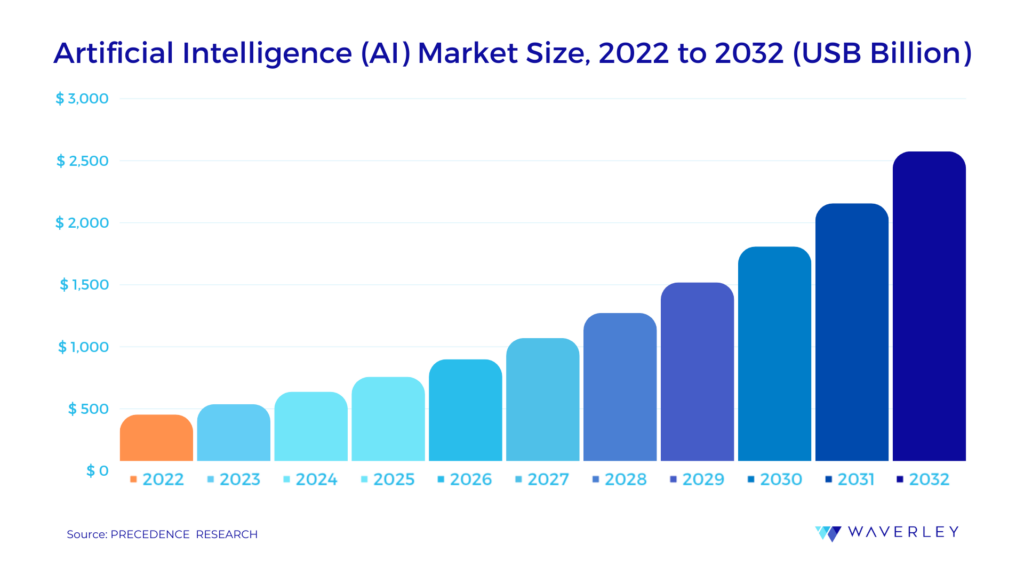
The largest share of the total AI market opportunity in 2023 belongs to North America. It is clear, that the region will remain the leading revenue contributor over the forecast period. North America has one of the highest numbers of AI/ML-related startups as well as several established technology companies looking to embed and utilize AI in their existing offerings. The US contributes the largest share of the AI revenue estimated for North America in 2023. This is mainly because the country hosts some of the largest tech companies like Apple, Google, IBM, and Microsoft, which have played a major role in the development and adoption of AI technology.
The country hosts many tech startups with a strong focus on developing AI products and services. Government initiatives to drive the development and adoption of AI and the steady flow of investments from both government and private establishments in the research and development of AI technology for use in various applications also make the US a major market for AI products and services.
Well-established industry sectors in the US, especially banking, financial services, and insurance (BFSI), automotive, and healthcare industries have been adding significant demand for AI technology in the country. Most of the leading BFSI, automotive, and pharmaceutical companies in the country have already been leveraging the power of AI in a range of applications, including process automation, customer experience management, etc.
However, Asia Pacific will continue to remain the second largest and the most attractive regional market for Artificial Intelligence through the forecast. The growth in the Asia Pacific region will largely be driven by a mix of institutional support for AI/ML commercialization by governments of countries like China, South Korea, and India.
The rising investments by organizations toward the integration of AI into businesses are boosting the demand for AI and ML projects.
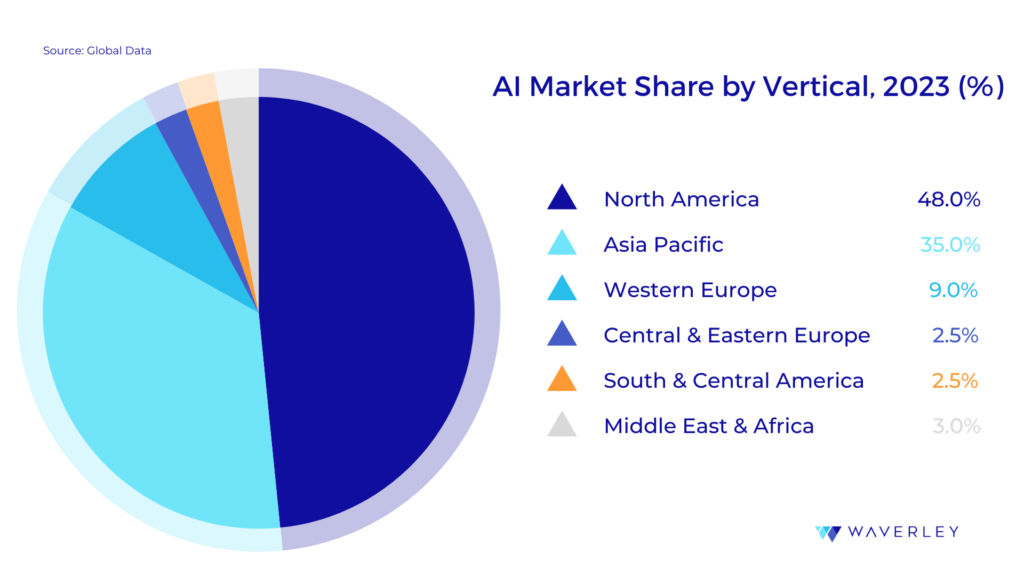
Key AI Statistics and Trends
- AI is expected to create 133 million new jobs by 2030
- AI will contribute over $15 trillion to the global economy by 2030
- Deployed AI adoption is over 40% in China and India
- 33% of all AI adoption cases focus on the automation of IT processes
- AI startup funding has increased on average by 66% between 2021 and 2023
- The demand for AI skills is outpacing the supply of AI talent
- Banking, financial services, insurance, and healthcare sectors have the biggest AI market share
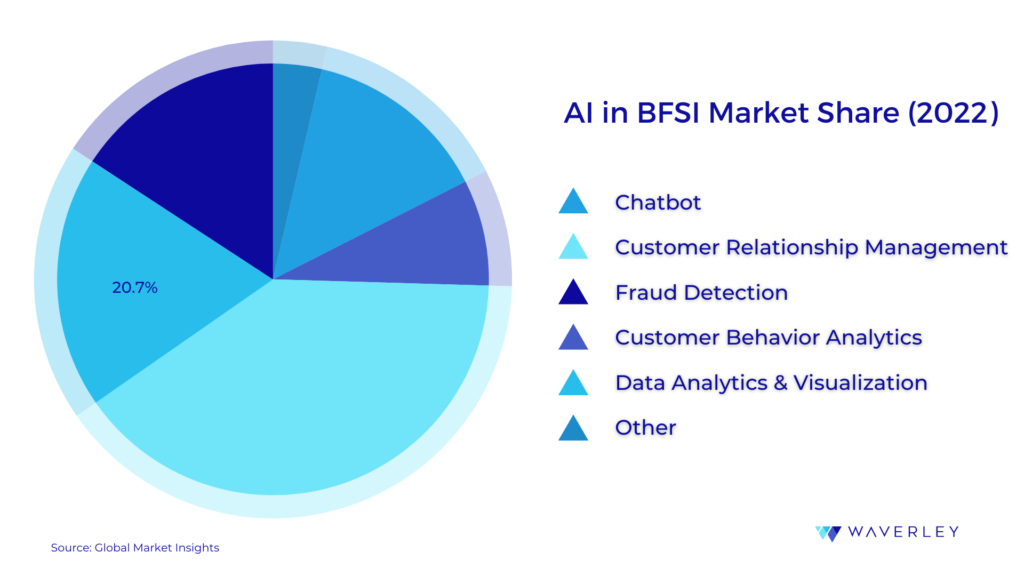
Overall, investments by the tech giants in R&D are continuously powering technological advancements in different industries. For example, the popularity of various life-saving medical devices and the self-driving feature in the new electric vehicles is boosting the growth of the AI market globally. The shifting focus of the globe towards digitalization is positively impacting market growth. The top global tech giants such as Google, Microsoft, IBM, Amazon, and Apple are increasing their investments in the development of various AI applications.
The Role of Programming Languages in AI and ML
The process of choosing a programming language for AI and ML is a significant moment since the success of the future project will depend on it. Before making the final decision it’s recommended to consider certain things. For example, efficiency, library support, and flexibility.
- Efficiency
We measure efficiency by the ability of a certain language to execute commands swiftly and optimally handle CPU and memory usage. An efficient language promotes faster development and deployment of AI and ML applications, which is vital in industries where rapid solution delivery can make a big difference. - Library support
Libraries are collections of pre-written code. In general, developers use libraries to save time and avoid repetition. They are particularly critical in AI and ML, where specific libraries can significantly accelerate the development process by providing ready-to-use algorithms and data structures. For AI and ML projects, development languages with a comprehensive range of robust libraries are preferred. - Flexibility
A flexible language is versatile and adaptable. Flexible languages also are capable of working in different environments and meeting various requirements. Basically, developers can mold the language to their needs, rather than adjusting the product to the language. In the active field of AI and ML, the flexibility of the programming language can be a major factor.
Taking into account the mentioned criteria, which programming language could be a suitable fit for AI and ML?
There are many popular AI programming languages such as Python, Java, Julia, Haskell, and Lisp. A suitable AI programming language should be easy to learn, read, and deploy. The language will determine how easily you can program AI applications, which and how many libraries, tools, and frameworks are available, how accessible is the documentation, and how active the community is to provide support if needed.
In general, Python is used in Artificial Intelligence and Machine Learning by most programmers. Other top competitors include Java, C++, and JavaScript — but Python is considered to be the best programming language for AI, according to Upwork’s research.
Let’s compare the major features of the mentioned languages to understand why Python is one of the best choices for AI and ML.
Top Reasons Why Python is the Best Choice For AI and ML
Python is the preferred choice by most of the AI developers. But why is Python so widely used in Artificial Intelligence and Machine Learning? And how exactly is Python used in AI and ML development? The answer lies in the top benefits of this programming language that have nothing to do with AI specifically.
- Simplicity and readability are the key reasons coders use Python for AI and Machine Learning. Python is designed to be easy to understand and write. It helps developers concentrate on the problem-solving aspects of AI and ML.
- Python allows you to run the script on GPU that can be comparatively faster than CPU. Enterprises generally prefer GPUs because most AI applications require parallel processing of multiple calculations, for example, neural networks accelerated AI, and deep learning operations with massive parallel inputs of data.
- Libraries. Another advantage of Python for AI and ML is the diversity of Python standard libraries that cover a lot of ground, reducing the need to code everything from scratch. Libraries such as NumPy, Pandas, Tensorflow, Pytorch and Matplotlib take care of the numerical aspects and data visualization, while SciPy brings in additional scientific computing capabilities.
- Interoperability is another advantage of Python. It leads to easy communication with other languages like C and C++, enabling it to leverage optimized code pieces for computationally intensive tasks. This results in a better performance. Moreover, Python’s extensive community support ensures that developers can quickly find solutions and get help when needed.
Why is Python the Optimal Choice for AI Development?
1. Rich Ecosystem of Libraries and Frameworks
As mentioned above, Python’s diversification of libraries is the key reason why Python is used for AI. A library is a module that is published by various sources, for example, PyPi which includes a pre-written piece of code. All of this allows users to reach some functionality or perform different actions. Python libraries provide base-level items so developers don’t have to code them from the very beginning every time. Regarding ML, it requires continuous data processing, but Python’s libraries let you access, handle, and transform data.
| Libraries | Usage |
|---|---|
| Scikit-learn | Is the best for handling basic ML algorithms like clustering, linear and logistic regressions, regression, classification, and others. |
| Scikit-image | Is used for image processing. |
| Pandas | Is applicable for high-level data structures and analysis. It allows merging and filtering of data, as well as gathering it from other external sources like Excel, for instance. |
| Keras | Is the best for handling basic ML algorithms like clustering, linear and logistic regressions, regression, classification, and others. |
| TensorFlow | It is suitable for working with deep learning by setting up, training, and utilizing artificial neural networks with massive datasets. |
| Matplotlib | Is applied for creating 2D plots, histograms, charts, and other forms of visualization. |
| NLTK | Coders are using it for working with computational linguistics, natural language recognition, and processing. Scikit-image works for image processing. |
| PyBrain | For neural networks, unsupervised, and reinforcement learning. |
| PyTorch | It is used for applications such as computer vision and natural language processing. |
2. Simple and Readable Syntax
Many coders agree that Python is more intuitive than other programming languages, which makes Python more user-friendly to work with and easy to learn. Developers can easily understand Python code, as well as understand the basics of Machine Learning. Moreover, since Python is a general-purpose language, it can do a set of complex ML tasks and enable building prototypes quickly, and testing the results of your work.
3. Strong Community Support
This is a very important factor because developers can access all the necessary educational information or materials easily. Additionally, Python is an open-source language, and a lot of Python documentation is available online as well as in AI communities and forums, where programmers and Machine Learning developers discuss errors, solve problems, and help each other out. The Python programming language is free as is the variety of useful libraries and tools.
4. Platform Independence
Why is Python an independent platform?
- It works on any platform (Linux, Windows, macOS)
- Python code can be used to create standalone executable programs
- Python software can be easily distributed and used on those operating systems without a Python interpreter
5. Popularity
The growing popularity of Python is predicted and expected. Its ability to integrate with emerging technologies, the dominance of Data Science and Machine Learning, and its advantages for web development and automation make Python a better choice compared to other programming languages.
When checking public repositories on GitHub it becomes evident that Python for ML is mentioned way more compared to other languages. Let’s review the data.
| Language | Public repositories |
|---|---|
| Python | 34,766 times |
| JavaScript | 2,998 times |
| R | 2,105 times |
| C++ | 1,926 times |
| MATLAB | 1,881 times |
| Java | 1,783 times |
| C# | 808 times |
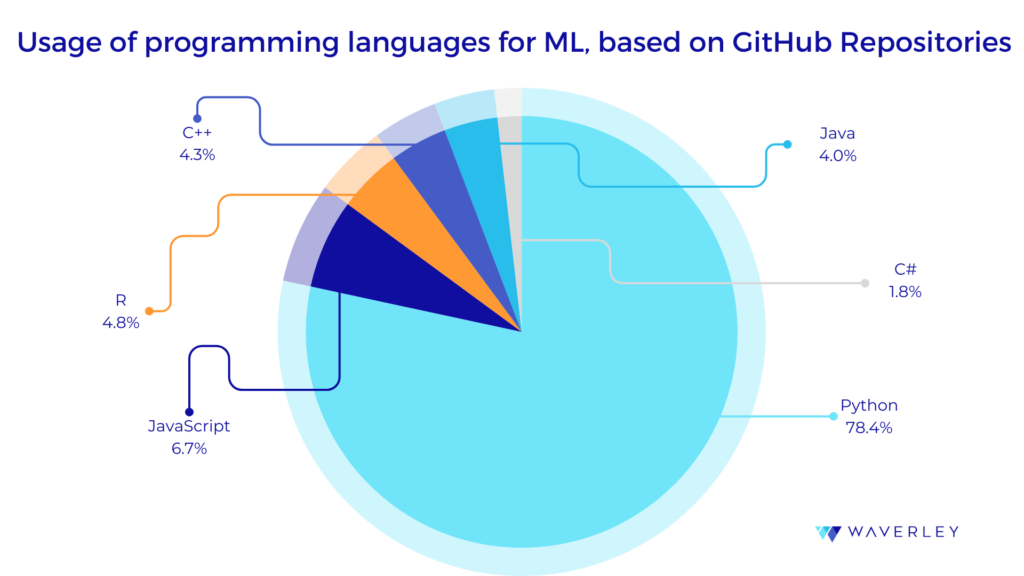
6. Data Analysis and Visualization
We’ve already mentioned that Python offers a variety of libraries and some of them are great visualization tools. It’s significant for AI coders to be able to represent data in a user-friendly format. So, libraries like Matplotlib allow data scientists to build charts, histograms, and plots for better data comprehension, effective presentation, and visualization.
7. Cross-Domain Versatility
Python can be used for multiple tasks such as: devising machines, learning algorithms, automation of machines, or just data analysis. In addition, Python is an excellent choice for web development, data science and analytics, AI/ML projects, etc.
Python Use Cases for AI and ML
Python grants many features helpful for AI and ML in particular, and this makes it the best programming language for AI. Therefore, it’s apparent why various industries and businesses use Python for predictions and Machine Learning tasks.
| Industry | Usage |
|---|---|
| Travel | AI assistants for booking (Skyscanner, Booking.com), AI-driven applications for flight forecasting (Hopper), room mapping + dynamic price tracking (Makcorps Hotel Pricing). |
| FinTech | Fraud detection and prevention (Stripe Radar), automated credit scoring (Credit Karma), personal finance management (Wally, Digit), and risk management (inscribe.ai). |
| Transportation | Autonomous vehicles (Tesla, BMW, Waymo, Audi), flight delay predictions, and real-time vehicle tracking. |
| Healthcare | Medical imaging (CT, MRI), electronic health records, early diagnosis of fatal blood diseases, and management of medical records, patient care apps (Aicure.com) |
| Education | Personalized language learning (Duolingo Max), ChatGPT-powered roleplay for soft skills development (Virtual Speech), interactive learning environments (Khan Academy). |
Other AI programming languages
As it was described, Python is among the most popular programming languages for AI development due to its versatile ecosystem of libraries. But other programming languages like Java, C++, and Haskell also play a fundamental role in creating AI systems.
| Programming language | Benefits for AI/ML Projects |
|---|---|
| Java | Various in-built modules and libraries like JUnit and Apache Commons save development time and facilitate the creation of high-performance applications. For instance, Java is commonly used in developing simulations, robotics, and embedded AI applications. A Java extension like RTSJ allows developers to create real-time systems like bots. Java also supports multithreading, which is crucial for AI tasks that need to run concurrently. |
| JavaScript | It’s primarily a client-side scripting language that runs directly on users’ browsers. As a result, it can help perform various computation tasks and improve the performance of AI applications. It’s also valuable when implementing real-time AI applications like virtual assistants, chatbots, and recommendation engines. |
| Julia | Julia is popular in the AI community, primarily because of its high performance and rapid prototyping capabilities. Julia offers fast processing abilities, which are essential in AI development because of the vast amounts of data involved. |
| Haskell | Haskell operates on a functional programming paradigm with core principles like pattern matching, high-order functions, and immutability, which are conducive to processing and manipulating complex data structures in AI development. |
| C++ | While C++ can interact with Machine Learning libraries like TensorFlow and PyTorch through bindings or APIs, these libraries are primarily designed for use with Python. However, the ability to use these libraries from C++ allows developers to integrate advanced functionalities into their applications rather than create everything from scratch. C++ supports parallel computing and has multithreading abilities. |
| R | R has a wide range of data visualization libraries, such as Ggplot2, Lattice, and Shiny, which allow developers to quickly create graphs, charts, and other visuals with their data. Its in-built functions, like glm and lm, allow professionals to use statistical modeling. |
Our Success Stories
Waverley Software is a prominent Python development company, we delivered many AI and ML projects across continents and domains.
| Machine Learning Algorithm for Healthcare | AI-Powered Virtual Assistant for Ideation Sessions |
|---|---|
| A team of data scientists developed a Machine Learning-based system to enable Natural Language Processing in Healthcare. The system processes patient notes and predicts which category the diagnosis falls into. | Waverley has partnered with a company of thinkers and innovators to implement a new kind of virtual assistant that can turn the idea-creation process upside down. |
We’re happy to help if you have questions about the AI benefits for your business, or thinking about how to integrate chatbots into business.
Summary: Python for AI and ML
The role of Python in Machine Learning, AI, and Data Science is very strong. That is why Python and Artificial Intelligence are so popular in combination with each other. All the advantages of Python for AI, such as expanded libraries, platform independence, and community support, make Python the best programming language for AI.
Waverley Software can assist you in implementing and integrating AI into your business across various industries.
FAQ
Why is Python good for AI development?
To answer the question of why Python is a good programming language for AI let’s check Python’s features. Extensive libraries/frameworks, strong industry adoption, full documentation, support for multi-paradigm programming, its versatility, and the variety of sources make Python a top choice for AI development. The language’s adaptability to various AI tasks, from data preprocessing to building complex Machine Learning models, has contributed to its prominence in the field.
Is Python used for ML better than Java?
Yes, Python is more commonly used for ML compared to Java. Since Python has extensive libraries (NumPy, TensorFlow) and simpler syntax, enabling faster development and experimentation, it is the preferred programming language.
What is the most popular language for AI and ML?
As of January 2023, the most popular language for AI and ML is Python, then there goes Java, Lisp, and R programming.
What are the main Python libraries for AI and Machine Learning?
Python offers a rich ecosystem of libraries for AI and Machine Learning. These include NumPy, Pandas, Scikit-learn, TensorFlow, PyTorch, Keras, Matplotlib, Seaborn, Plotly, and NLTK (Natural Language Toolkit).
Does Python’s simplicity compromise performance in AI and ML tasks?
Yes, it does. Python’s simplicity can have implications for performance in certain AI and ML tasks.
Explore Python for AI and ML opportunities.



